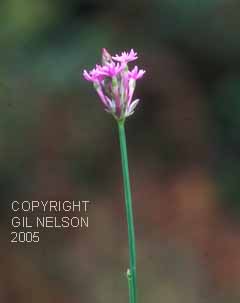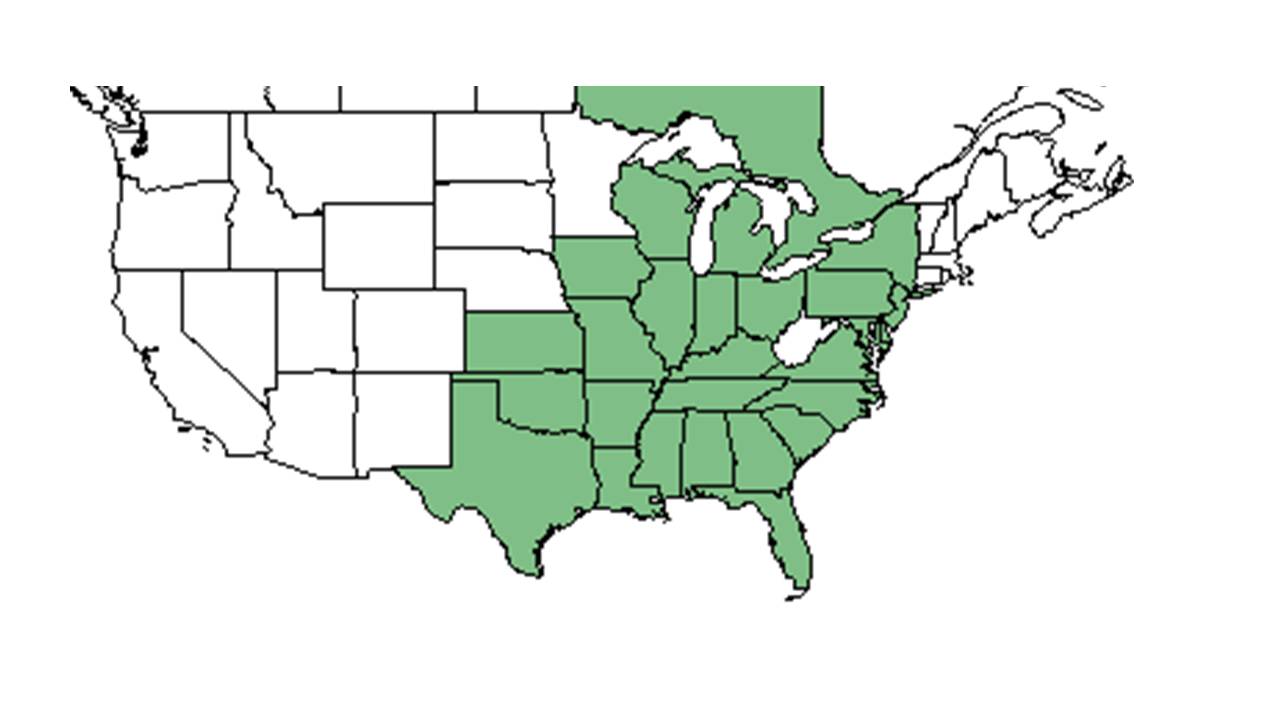Difference between revisions of "Polygala incarnata"
(→Taxonomic notes) |
|||
| (34 intermediate revisions by 12 users not shown) | |||
| Line 15: | Line 15: | ||
| binomial_authority = L. | | binomial_authority = L. | ||
| range_map = POLY_INCA_dist.jpg | | range_map = POLY_INCA_dist.jpg | ||
| − | | range_map_caption = Natural range of ''Polygala incarnata'' from USDA NRCS [http:// | + | | range_map_caption = Natural range of ''Polygala incarnata'' from USDA NRCS [http://plants.usda.gov/core/profile?symbol=POIN4 Plants Database]. |
}} | }} | ||
| + | |||
| + | Common names: procession flower, pink milkwort | ||
| + | ==Taxonomic notes== | ||
| + | Synonym: ''Galypola incarnata'' (Linnaeus) Nieuwland<ref name=weakley>Weakley, A.S. 2020. Flora of the Southeastern United States. Edition of 20 October 2020. University of North Carolina at Chapel Hill, Chapel Hill, North Carolina.</ref> | ||
| + | |||
| + | Varieties: none<ref name=weakley/> | ||
| + | |||
==Description== | ==Description== | ||
<!-- Basic life history facts such as annual/perrenial, monoecious/dioecious, root morphology, seed type, etc. --> | <!-- Basic life history facts such as annual/perrenial, monoecious/dioecious, root morphology, seed type, etc. --> | ||
| − | + | "Herbs, whorled or alternate rarely opposite, entire leaves. Flowers lavender, pink, white or yellow, in racemes or spikes, terminating the branches or in terminal corymbs. Flowers perfect, zygomorphic, with 3 small sepals, frequently one of these slightly larger than the others, and 2 larger petaloid sepals (wigs). The 3 petals are united into a tube, 3-lobed at apex, the 2 lateral lobes usually the longer, the center lobe usually lacerate, often thicker in texture; stamens 6-8, united to the corolla tube in 2 rows. Capsule 2 –locular, with one seed in each locule. Seeds dark brown or black, ellipsoid or ovoid, rarely globose, 0.5-3 mm long, usually densely pubescent. The genus has been divided into several genera none of which have distinct characteristics. Orange flowers turn pale yellow on drying, yellow ones bluish green; the pink or lavender ones remain the same color or fade slightly."<ref name="Radford et al 1964">Radford, Albert E., Harry E. Ahles, and C. Ritchie Bell. Manual of the Vascular Flora of the Carolinas. 1964, 1968. The University of North Carolina Press. 658. Print.</ref> | |
| + | |||
| + | "Glabrous, glaucous annual. Stems strict to slightly branched, the cotyledons often present at flowering time. Leaves fleshy, alternate, linear, 5-17 mm long, setaceous or sharply acute. Flowers in spike or racemes; pedicels 1 mm or less long or absent. Sepals ca. 1 mm long, pink, acute or acuminate, wings similar but larger, 2.5-3 mm long, oblanceolate, pink; corolla tube reddish pink, prominently fringed, 5-6.5 mm long; stamens 8. Seeds black, 1-1.7 mm long; aril confined to base, lobe 1, scarcely projecting."<ref name="Radford et al 1964"/> | ||
==Distribution== | ==Distribution== | ||
==Ecology== | ==Ecology== | ||
===Habitat=== <!--Natural communities, human disturbed habitats, topography, hydrology, soils, light, fire regime requirements for removal of competition, etc.--> | ===Habitat=== <!--Natural communities, human disturbed habitats, topography, hydrology, soils, light, fire regime requirements for removal of competition, etc.--> | ||
| − | This species has been found in longleaf pine flatwoods, near sphagnum filled boggy areas, and savannas in drying and moist loamy sands of well drained uplands | + | This species has been found in longleaf pine flatwoods, near sphagnum filled boggy areas, and savannas in drying and moist loamy sands of well drained uplands.<ref name="FSU Herbarium">Florida State University Robert K. Godfrey Herbarium database. URL: [http://herbarium.bio.fsu.edu http://herbarium.bio.fsu.edu]. Last accessed: June 2014. Collectors: Loran C. Anderson, R. A. Norris, Rodie White, R. Komarek, R. F. Doren, Robert K. Godfrey, and M. Davis. States and Counties: Florida: Jefferson, Wakulla, and Washington. Georgia: Grady and Thomas.</ref> It has also been found in the sand pine scrub of Ocala National Forest.<ref name="Greenberg 2003"/>''P. incarnata'' has also been seen growing in disturbed habitats such as raked fire breaks of upland longleaf pine-wiregrass communities at Pebble Hill Plantation.<ref name="DiSabatino">DiSabatino, Dante G. 2015. Personal observation at Pebble Hill Plantation, Grady County, GA</ref> Associated species include longleaf pine and wiregrass.<ref name="FSU Herbarium"/> |
| + | ===Phenology=== <!--Timing off flowering, fruiting, seed dispersal, and environmental triggers. Cite PanFlora website if appropriate: http://www.gilnelson.com/PanFlora/ --> | ||
| + | ''P. incarnata'' has been observed flowering from April to July and in September with peak inflorescence in May.<ref name="FSU Herbarium"/><ref>Nelson, G. [http://www.gilnelson.com/ PanFlora]: Plant data for the eastern United States with emphasis on the Southeastern Coastal Plains, Florida, and the Florida Panhandle. www.gilnelson.com/PanFlora/ Accessed: 12 DEC 2016</ref> | ||
| + | <!--===Seed dispersal===--> | ||
| + | <!--===Seed bank and germination===--> | ||
| + | ===Fire ecology=== <!--Fire tolerance, fire dependence, adaptive fire responses--> | ||
| + | ''Polygala incarnata'' occurs in areas that are on frequent burn intervals,<ref name="FSU Herbarium"/> as evidenced by populations known to persist through repeated annual burning.<ref>Platt, W.J., R. Carter, G. Nelson, W. Baker, S. Hermann, J. Kane, L. Anderson, M. Smith, K. Robertson. 2021. Unpublished species list of Wade Tract old-growth longleaf pine savanna, Thomasville, Georgia.</ref> | ||
| + | <!--===Pollination===--> | ||
| + | <!--===Herbivory and toxicology===<!--Common herbivores, granivory, insect hosting, poisonous chemicals, allelopathy, etc--> | ||
| + | <!--===Diseases and parasites===--> | ||
| − | == | + | ==Conservation, cultivation, and restoration== |
| − | |||
| − | == | + | ==Cultural use== |
| − | |||
| − | |||
| − | |||
| − | |||
| − | |||
| − | |||
| − | |||
==Photo Gallery== | ==Photo Gallery== | ||
| + | <gallery widths=180px> | ||
| + | </gallery> | ||
==References and notes== | ==References and notes== | ||
| − | |||
Latest revision as of 14:33, 14 July 2023
| Polygala incarnata | |
|---|---|

| |
| Photo taken by Gil Nelson | |
| Scientific classification | |
| Kingdom: | Plantae |
| Division: | Magnoliophyta – Flowering plants |
| Class: | Magnoliopsida – Dicotyledons |
| Order: | Polygalales |
| Family: | Polygalaceae |
| Genus: | Polygala |
| Species: | P. incarnata |
| Binomial name | |
| Polygala incarnata L. | |

| |
| Natural range of Polygala incarnata from USDA NRCS Plants Database. | |
Common names: procession flower, pink milkwort
Contents
Taxonomic notes
Synonym: Galypola incarnata (Linnaeus) Nieuwland[1]
Varieties: none[1]
Description
"Herbs, whorled or alternate rarely opposite, entire leaves. Flowers lavender, pink, white or yellow, in racemes or spikes, terminating the branches or in terminal corymbs. Flowers perfect, zygomorphic, with 3 small sepals, frequently one of these slightly larger than the others, and 2 larger petaloid sepals (wigs). The 3 petals are united into a tube, 3-lobed at apex, the 2 lateral lobes usually the longer, the center lobe usually lacerate, often thicker in texture; stamens 6-8, united to the corolla tube in 2 rows. Capsule 2 –locular, with one seed in each locule. Seeds dark brown or black, ellipsoid or ovoid, rarely globose, 0.5-3 mm long, usually densely pubescent. The genus has been divided into several genera none of which have distinct characteristics. Orange flowers turn pale yellow on drying, yellow ones bluish green; the pink or lavender ones remain the same color or fade slightly."[2]
"Glabrous, glaucous annual. Stems strict to slightly branched, the cotyledons often present at flowering time. Leaves fleshy, alternate, linear, 5-17 mm long, setaceous or sharply acute. Flowers in spike or racemes; pedicels 1 mm or less long or absent. Sepals ca. 1 mm long, pink, acute or acuminate, wings similar but larger, 2.5-3 mm long, oblanceolate, pink; corolla tube reddish pink, prominently fringed, 5-6.5 mm long; stamens 8. Seeds black, 1-1.7 mm long; aril confined to base, lobe 1, scarcely projecting."[2]
Distribution
Ecology
Habitat
This species has been found in longleaf pine flatwoods, near sphagnum filled boggy areas, and savannas in drying and moist loamy sands of well drained uplands.[3] It has also been found in the sand pine scrub of Ocala National Forest.[4]P. incarnata has also been seen growing in disturbed habitats such as raked fire breaks of upland longleaf pine-wiregrass communities at Pebble Hill Plantation.[5] Associated species include longleaf pine and wiregrass.[3]
Phenology
P. incarnata has been observed flowering from April to July and in September with peak inflorescence in May.[3][6]
Fire ecology
Polygala incarnata occurs in areas that are on frequent burn intervals,[3] as evidenced by populations known to persist through repeated annual burning.[7]
Conservation, cultivation, and restoration
Cultural use
Photo Gallery
References and notes
- ↑ 1.0 1.1 Weakley, A.S. 2020. Flora of the Southeastern United States. Edition of 20 October 2020. University of North Carolina at Chapel Hill, Chapel Hill, North Carolina.
- ↑ 2.0 2.1 Radford, Albert E., Harry E. Ahles, and C. Ritchie Bell. Manual of the Vascular Flora of the Carolinas. 1964, 1968. The University of North Carolina Press. 658. Print.
- ↑ 3.0 3.1 3.2 3.3 Florida State University Robert K. Godfrey Herbarium database. URL: http://herbarium.bio.fsu.edu. Last accessed: June 2014. Collectors: Loran C. Anderson, R. A. Norris, Rodie White, R. Komarek, R. F. Doren, Robert K. Godfrey, and M. Davis. States and Counties: Florida: Jefferson, Wakulla, and Washington. Georgia: Grady and Thomas.
- ↑ Cite error: Invalid
<ref>tag; no text was provided for refs namedGreenberg 2003 - ↑ DiSabatino, Dante G. 2015. Personal observation at Pebble Hill Plantation, Grady County, GA
- ↑ Nelson, G. PanFlora: Plant data for the eastern United States with emphasis on the Southeastern Coastal Plains, Florida, and the Florida Panhandle. www.gilnelson.com/PanFlora/ Accessed: 12 DEC 2016
- ↑ Platt, W.J., R. Carter, G. Nelson, W. Baker, S. Hermann, J. Kane, L. Anderson, M. Smith, K. Robertson. 2021. Unpublished species list of Wade Tract old-growth longleaf pine savanna, Thomasville, Georgia.